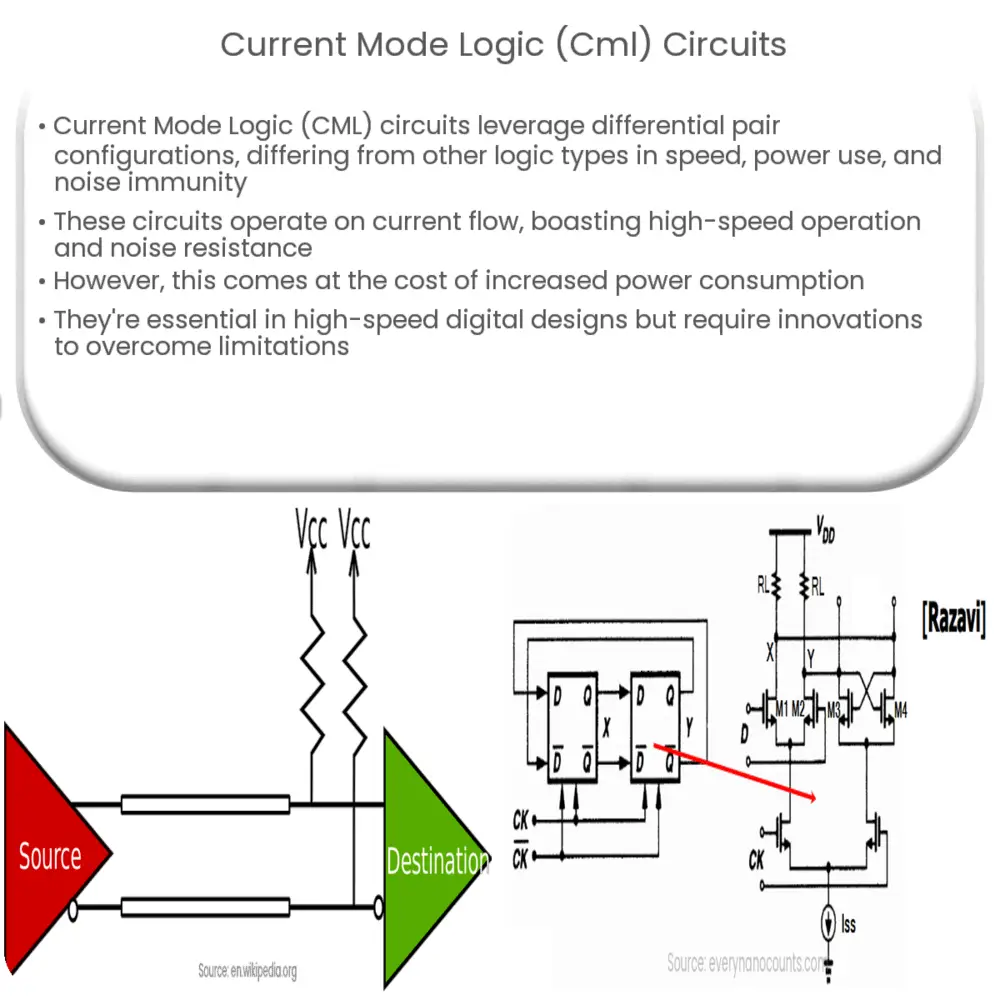Explore the principles, advantages, and applications of Current Mode Logic (CML) circuits, vital for high-speed digital design.

Introduction to Current Mode Logic (CML) Circuits
Current Mode Logic (CML), also known as Emitter-Coupled Logic (ECL), is a digital logic family that leverages the principles of differential pair configurations in its design. It is fundamentally distinguished from other logic families by its operational principles, speed, power consumption, and noise immunity characteristics.
Operating Principles of CML
The basic operating principles of CML circuits are founded on the balanced differential amplifier configuration. Unlike conventional logic circuits that operate based on voltage levels, CML circuits operate based on current flow. The inputs to a CML gate are balanced differential currents. In a typical CML gate, the output stage consists of a differential pair of transistors with active load.
Speed and Power Consumption
CML circuits are known for their high-speed operation. They are often utilized in applications where speed is a critical factor. This is made possible due to the constant current flow in the circuit, regardless of the logic state. This characteristic eliminates the need for charging and discharging parasitic capacitances, which can slow down the operation in other logic families.
While high-speed operation is an advantage, it comes with the trade-off of higher power consumption. The constant current flow, even when the circuit is idle, contributes to the higher power dissipation in CML circuits. Therefore, they are not generally recommended for power-constrained applications.
Noise Immunity
CML circuits exhibit excellent noise immunity. The differential nature of the input signals, coupled with the differential amplifier configuration, provides inherent noise immunity. This property makes CML circuits especially suitable for high-frequency and high-noise environments.
Applications of CML Circuits
Due to their high-speed operation and noise immunity, CML circuits find a plethora of applications in digital systems. They are particularly utilized in the design of high-speed data transmission systems, analog-to-digital converters (ADCs), and clock distribution networks. The low signal swing (2), which minimizes the radiated emissions, further augments their usage in high-speed communication systems.
CML circuits are also used in implementing various high-speed digital circuits such as flip-flops, counters, and shift registers.
Design of CML Circuits
Designing CML circuits requires a careful balance of several factors. Since CML is a current-switching logic, the design primarily focuses on managing current flows. A fundamental design parameter is the emitter current, which directly affects the speed of operation, power consumption, and the output swing of the CML gate. The choice of current source values, component values, and the use of complementary outputs are other crucial aspects of CML design.
Advantages and Limitations
CML circuits offer several advantages over other logic families, the most prominent being their high-speed operation. Their inherent noise immunity and low output signal swing also contribute to their wide usage in high-frequency applications. Moreover, CML circuits’ differential operation enables them to maintain consistent performance across a wide range of temperature and process variations.
However, there are limitations as well. The high power consumption is the primary downside of CML circuits. They may not be suitable for applications where power efficiency is crucial. Additionally, the complexity of the design and the need for negative power supplies can be challenging in certain implementation contexts.
Conclusion
In summary, Current Mode Logic (CML) circuits present a unique blend of characteristics that make them an indispensable tool in the world of high-speed digital design. They offer remarkable speed and noise immunity, despite the trade-off of higher power consumption. As technology continues to evolve, with a growing demand for faster and more reliable digital systems, the relevance of CML circuits is unlikely to fade. However, continuous research and innovation will be needed to mitigate their limitations and enhance their power efficiency, thereby widening their scope of application in the future digital world.

